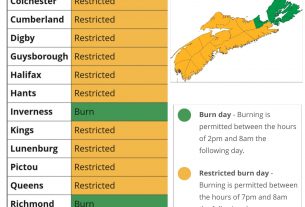**** Info via Environment Canada
October temperature outlook via Environment Canada
Let’s have a look at the map for the month of October, to see whether temperatures in your region will be below- or above-average.
The forecasts are categorized as follows:
- blue indicates the probability that temperatures will be below normal;
- grey to purple indicates the probability that temperatures will be near normal;
- yellow to red indicates the probability that temperatures will be above normal; and
- white indicates uncertainty regarding the temperature tendency this month.
All categories are compared to the 30 months of October between the 1991-2020 period. This map is a prediction of the daily average temperature anomaly (difference from normal) at 2 metres, the standard forecast height. It is not a daily maximum or minimum temperature forecast.
Long-range forecast user guide.
September overview
Except for parts of the Maritimes, Labrador and the far north, September brought below-average precipitation across Canada, continuing the trend of generally dry conditions that we have seen in spring and summer.
Map of the precipitation anomaly (difference from normal) across the country for September.
September was also warmer than average across most of the country except for British Columbia and parts of Yukon. As summer moved into fall, cooling temperatures brought snow through higher elevations in British Columbia and Alberta and through parts of the north. These cooling temperatures helped decrease the number and intensity of forest fires, which was welcomed after a record fire season.
Map of the temperature anomaly (difference from normal) across the country for September.
Smoke from fires this year caused extended periods of poor air quality, and shattering records for the number of smoke hours experienced in many communities (a “smoke hour” is when visibility is reduced to 9.7 km or less due to smoke). For instance, as of September 5, Grande Prairie, Alberta, had accumulated 625 smoke hours, breaking the previous record of 194 smoke hours set in 2018, with records being kept since 1953. La Ronge, Saskatchewan, experienced 802 smoke hours, surpassing the old record of 194 smoke hours set in 2015, with records kept since 1959.
In Atlantic Canada, the storm that had once been Hurricane Lee made landfall in Long Island, Nova Scotia, as a post-tropical storm on Saturday, September 16. This brought wind gusts of 117 km/h to the Halifax area and over 100 mm of rain to parts of New Brunswick and the Gaspé region in Quebec.
The first major windstorm of the season hit British Columbia on September 24 and 25, bringing up to 161 km/h gusts to Solander Island, located off the northern coast of Vancouver Island.




